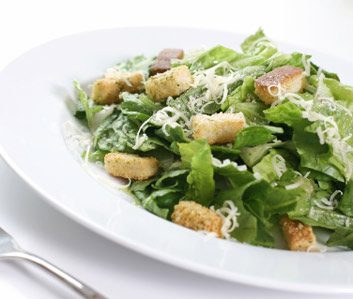
1. Salads
“Just because [a dish] has the word ‘salad’ in it, doesn’t mean it’s automatically healthy,” warns Zannat Reza, a registered dietitian based in Toronto. That’s especially true of restaurant salads, some of which come in giant-size servings that pack a hefty calorie punch. Take Taco Bell’s Fiesta Taco Salad, which contains 820 calories and 1,740 milligrams of sodium; or Wendy’s Chicken BLT Salad with croutons and honey Dijon dressing, with 790 calories and 1,665 milligrams of sodium.
“To put this in perspective, lunch should be around 400 to 500 calories and you only need 1,500 milligrams of sodium a day,” says Reza.
But don’t think of giving up on your favourite veggie-packed meal-just watch your portion size and cut back on the calorie-packed extras such as crunchy noodles and heavy dressings. Whenever possible, order dressing on the side so you can add a reasonable amount, and make salads at home so you know exactly what you’re eating.
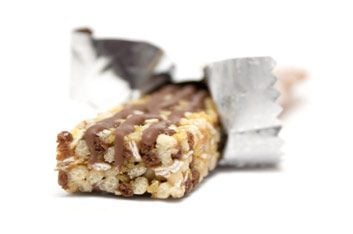
2. Granola bars
Don’t be fooled by these seemingly good-for-you snacks-some granola bars contain serious amounts of sugar.
“You really have to check the fine print,” Reza warns. “Even if the box says [the product is] ‘whole grain,’ some brands list sugar as their first ingredient and those are the ones you want to stay away from.” Also be aware that while the yogurt topping on some bars may be made with yogurt powder, it doesn’t offer the health benefits that an actual cup of yogurt would. The same goes for the bars that contain “real fruit filling,” which is not the same as eating a serving of fruit. Instead, choose a granola bar that lists a whole grain as the first ingredient on the box and contains at least two grams of fibre.
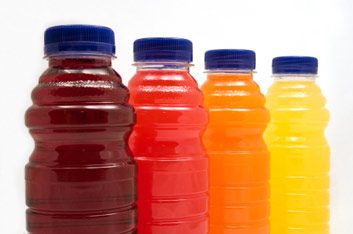
3. Juice
“Sometimes there are products on the market that look like juice, but they’re what I call juice-wannabes,” says Reza. Just because packaging says “contains real fruit juice” doesn’t mean the beverage inside is good for you. Drinks labelled as “real fruit beverage,” “fruit punch” or “fruit cocktail” often contain so much sugar, you might as well be drinking pop.
Even 100 percent fruit juice should be enjoyed in moderation. “You don’t want to be drinking more than a cup [of juice] a day because there’s hardly any fibre in it and it’s just an easy way to chug down calories,” says Reza.
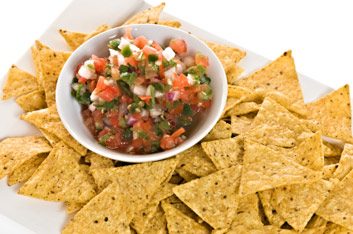
5. Whole-wheat tortilla chips
They may seem like a more nutritious choice, but let’s compare: a serving of Multigrain Tostitos contains 150 calories and two grams of fibre, while a serving of Restaurant Style Tostitos contains the same amount of fibre and 140 calories. Not much difference there.
“When you look on the ingredient list [of these chips], sometimes the whole grain is the fourth or fifth ingredient, which means there’s really not a lot of it in that particular product. It’s really more of a marketing thing,” says Reza. That doesn’t necessarily mean you should cut out tortilla chips-just remember that even the ones labelled “whole grain” should be enjoyed in moderation.
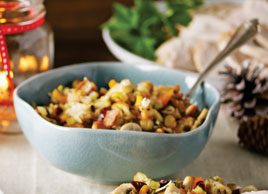
4. Fat-free salad dressings
These salad toppers may seem like a good choice for your leafy greens, but Reza says she isn’t a fan. “Sometimes people think fat-free salad dressings are great for them, but you need a bit of fat in your salad dressing to help you absorb the vitamin A in the salad that you’re eating,” she says. You also might be tempted to drench your veggies with a dressing labelled fat-free, which could add more calories and sodium to your meal.
Instead of dressing your salad with zero-fat options, Reza recommends adding a tablespoon or two of balsamic vinegar mixed with olive oil. If you really love the creamy stuff, she suggests dipping your fork in a small portion on the side before eating a mouthful of salad rather than drizzling dressing on top.
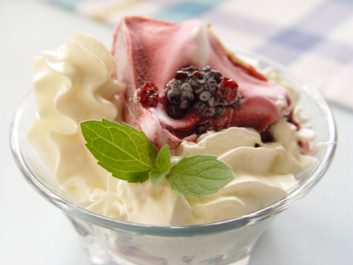
6. Frozen yogurt
Many of these frozen desserts contain a lot of sugar, which makes up for their lack of fat. That brings the calorie count of some frozen yogurts up to almost the same level as ice cream. “According to the Canadian Nutrient File, which takes averages of different brands, a 1/2 cup of vanilla frozen yogurt is 124 calories and a 1/2 cup of vanilla ice cream is 153 calories,” says Reza. “That’s not a huge difference.”
So when you’re craving a frozen dessert, you might as well go for the ice cream. Just watch your portion size-try ordering a kiddie scoop of your favourite flavour rather than a regular-size frozen yogurt, or buy pre-wrapped, reasonably sized bars for instant portion control.
Related:
• 6 foods you thought weren’t healthy but are
• 6 healthier fast food choices
• 10 quick and healthy snacks to stash at work
